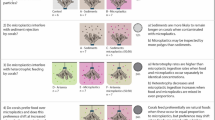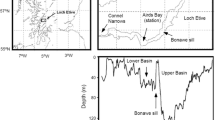Abstract
Bioeroding sponges are important macroborers that chemically cut out substrate particles (chips) and mechanically remove them, thereby contributing to reef-associated sediment. These chemical and mechanical proportions vary with elevated levels of partial pressure of carbon dioxide (pCO2). To assess related impacts, the morphometric parameters “chip diameter” and “etching fissure width” were analyzed for Cliona orientalis Thiele, 1900, hypothesizing that their dimensions would differ with different pCO2 exposures (72 h at ca. 400, 750 and 1700 μatm). Under ambient conditions, we obtained a mean chip diameter of 21.6 ± 0.7 μm and a mean fissure width of 0.29 ± 0.01 μm. Chips were evenly distributed across the medium and coarse silt fractions regardless of treatment. We could not find a reliable pCO2 treatment effect for chip diameter and fissure width, but we observed strong data variability not related to our key questions. A hierarchical data design further reduced the test power. Fissure width was the more sensitive, but also more variable parameter. Sample size analyses nevertheless indicated that we had processed enough data. Thus, we reject our scenario of an increase in fissure width and consequent reduction in chip size to explain why chemical sponge bioerosion increases more strongly than the mechanical counterpart. Instead, we propose that a lowered ambient pH may favor respiratory acid build-up in the sponge tissue, possibly leading to a less localized bioerosion, causing bias towards more chemical bioerosion. Overall, this does not seem to affect the morphometry of sponge chips and the quality of sponge-generated sediment.









Similar content being viewed by others
References
Achlatis M, Schönberg CHL, van der Zande R, LaJeunesse T, Hoegh-Guldberg O, Dove S (in press) Photosynthesis by symbiotic sponges enhances their ability to erode calcium carbonate. J Exp Mar Biol Ecol
Acker KL, Risk MJ (1985) Substrate destruction and sediment production by the boring sponge Cliona caribbaea on Grand Cayman Island. J Sediment Res 55:705–711. https://doi.org/10.1306/212F87C4-2B24-11D7-8648000102C1865D
Adjas A, Masse J-P, Montaggioni LF (1990) Fine-grained carbonates in nearly closed reef environments: Mataiva and Takapoto atolls, Central Pacific Ocean. Sediment Geol 67:115–132. https://doi.org/10.1016/0037-0738(90)90030-W
Alvarado JJ, Grassian B, Cantera-Kintz JR, Carballo JL, Londoño-Cruz E (2017) Coral reef bioerosion in the eastern tropical Pacific. In: Glynn P, Manzello D, Enochs I (eds) Coral reefs of the Eastern Tropical Pacific. Springer, Berlin, pp 369–403. https://doi.org/10.1007/978-94-017-7499-4_12
Bros WE, Cowell BC (1987) A technique for optimizing sample size (replication). J Exp Mar Biol Ecol 114:63–71. https://doi.org/10.1016/0022-0981(87)90140-7
Calcinai B, Cerrano C, Bavestrello G (2002) A new species of Scantiletta (Demospongiae, Clionaidae) from the Mediterranean precious red coral with some remarks on the genus. Bull Mar Sci 70(3):919–926
Calcinai B, Cerrano C, Bavestrello G (2007) Three new species and one re-description of Aka. J Mar Biol Assoc UK 87(6):1355–1365. https://doi.org/10.1017/S0025315407058377
Carballo JL, Ovalle-Beltrán H, Yáñez B, Bautista-Guerrero E, Nava-Bravo H (2016) Assessment of the distribution of sponge chips in the sediment of East Pacific Ocean reefs. Mar Ecol 38:e12390. https://doi.org/10.1111/maec.12390
Chisholm JRM, Gattuso J-P (1991) Validation of the alkalinity anomaly technique for investigating calcification of photosynthesis in coral reef communities. Limnol Oceanogr 36(6):1232–1239. https://doi.org/10.4319/lo.1991.36.6.1232
Donn TF, Boardman MR (1988) Bioerosion of rocky carbonate coastlines on Andros Island, Bahamas. J Coast Res 4(3):381–394
Fang JKH, Mello-Athayde MA, Schönberg CHL, Kline DI, Hoegh-Guldberg O, Dove S (2013) Sponge biomass and bioerosion rates increase under ocean warming and acidification. Glob Change Biol 19(12):3581–3591. https://doi.org/10.1111/gcb.12334
Fang JKH, Schönberg CHL, Hoegh-Guldberg O, Dove S (2016) Day–night ecophysiology of the photosymbiotic bioeroding sponge Cliona orientalis Thiele, 1900. Mar Biol 163:100. https://doi.org/10.1007/s00227-016-2848-4
Field A (2009) Calculating the effect size. Discovering statistics using SPSS, 3rd edn. Sage Publications, London, pp 389–390
Fütterer DK (1974) Significance of the boring sponge Cliona for the origin of fine grained material of carbonate sediments. J Sediment Res 44:79–84. https://doi.org/10.1306/74d72987-2b21-11d7-8648000102c1865d
Glynn PW, Manzello DP (2015) Bioerosion and coral reef growth: a dynamic balance. In: Birkeland C (ed) Coral reefs in the Anthropocene. Springer, Dordrecht, pp 67–97. https://doi.org/10.1007/978-94-017-7249-5_4
Goreau TF, Hartman WD (1963) Boring sponges as controlling factors in the formation and maintenance of coral reefs. In: Sognnaes RF (ed) Mechanisms of hard tissue destruction, vol 75. Amer Assoc Adv Sci Publ, Washington, pp 25–54
Halley RB, Shinn EA, Hudson JH, Lidz B (1977) Recent and relict topography of Boo Bee patch reef, Belize. In: Proceedings 3rd international coral reef symposium, Miami, pp 29–35
Hammer Ø, Harper DAT, Ryan PD (2001) PAST: paleontological statistics software package for education and data analysis. Palaeontol Electron 4:1–9
Kadam P, Bhalerao S (2010) Sample size calculation. Int J Ayurveda Res 1(1):55–57
Land LS (1979) The fate of reef-derived sediment on the north Jamaican island slope. Mar Geol 29(1–4):55–71. https://doi.org/10.1016/0025-3227(79)90102-6
MacGeachy JK, Stearn CW (1976) Boring by macro-organisms in the coral Montastrea annularis on Barbados reefs. Int Rev ges Hydrobiol 61(6):715–745
Maldonado M, Giraud K, Carmona C (2008) Effects of sediment on the survival of asexually produced sponge recruits. Mar Biol 154(4):631–641. https://doi.org/10.1007/s00227-008-0956-5
Mallela J, Perry CT (2007) Calcium carbonate budgets for two coral reefs affected by different terrestrial runoff regimes, Rio Bueno, Jamaica. Coral Reefs 26(1):129–145. https://doi.org/10.1007/s00338-006-0169-7
Marlow J, Schönberg CHL, Davy SK, Haris A, Jompa J, Bell JJ (2018) Bioeroding sponge assemblages: the importance of substrate availability and sediment. J Mar Biol Assoc UK. https://doi.org/10.1017/S0025315418000164
Moore Jr CH, Shedd WW (1977) Effective rates of sponge bioerosion as a function of carbonate production. In: Proceedings 3rd international coral reef symposium, Miami, pp 499–505
Moore Jr CH, Graham EA, Land LS (1976) Sediment transport and dispersal across the deep fore-reef and island slope (− 55 m to − 305 m), Discovery Bay, Jamaica. J Sediment Res 46(1):174–187. https://doi.org/10.1306/212F6EEC-2B24-11D7-8648000102C1865D
Pomponi SA (1980) Cytological mechanisms of calcium carbonate excavation by boring sponges. Int Rev Cytol 65:301–319. https://doi.org/10.1016/S0074-7696(08)61963-4
Rützler K (1975) The role of burrowing sponges in bioerosion. Oecologia 19(3):203–216. https://doi.org/10.1007/BF00345306
Rützler K (2002) Impact of crustose clionid sponges on Caribbean reef corals. Acta Geol Hisp 37(1):61–72
Rützler K, Rieger G (1973) Sponge burrowing: fine structure of Cliona lampa penetrating calcareous substrata. Mar Biol 21(2):144–162. https://doi.org/10.1007/BF00354611
Schaetzl RJ, Thompson ML (2015) Solids. In: Schaetzl RJ, Thompson ML (eds) Soils. Genesis and morphology, 2nd edn. Cambridge University Press, Cambridge, p 778
Schneider CA, Rasband WS, Eliceiri KW (2012) NIH Image to ImageJ: 25 years of image analysis. Nat Methods 9(7):671–675
Schönberg CHL (2000) Bioeroding sponges common to the Central Australian Great Barrier Reef: descriptions of three new species, two new records, and additions to two previously described species. Senckenb Marit 30(3–6):161–221. https://doi.org/10.1007/BF03042965
Schönberg CHL (2008) A history of sponge erosion: from past myths and hypotheses to recent approaches. In: Wisshak M, Tapanila L (eds) Current developments in bioerosion. Springer, Berlin, pp 165–202. https://doi.org/10.1007/978-3-540-77598-0_9
Schönberg CHL (2016) Effects of dredging on filter feeder communities, with a focus on sponges. Final report of project 6.1 of the Dredging Science Node of the Western Australian Marine Science Institution, Perth, Western Australia, p 127. http://www.wamsi.org.au/sites/wamsi.org.au/files/files/Effects_of_Dredging_on_Filter_Feeders_Review_WAMSI_DSN_Report_6_1_Schönberg_2016_FINAL.pdf. Accessed 02 Aug 2018
Schönberg CHL, Ortiz J-C (2009) Is sponge bioerosion increasing? In: Proceedings of the 11th international coral reef symposium, Ft. Lauderdale, Florida, USA, pp 520–523
Schönberg CHL, Suwa R (2007) Why bioeroding sponges may be better hosts for symbiotic dinoflagellates than many corals. In: Custódio MR, Lôbo-Hajdu G, Hajdu E, Muricy G (eds) Porifera research. Biodiversity, innovation and sustainability. Museu Nacional, Rio de Janeiro, pp 569–580
Schönberg CHL, Fang JKH, Carballo JL (2017a) Bioeroding sponges and the future of coral reefs. In: Carballo JL, Bell JJ (eds) Climate change, ocean acidification and sponges. Springer International, Cham, pp 179–372. https://doi.org/10.1007/978-3-319-59008-0_7
Schönberg CHL, Fang JKH, Carreiro-Silva M, Tribollet A, Wisshak M (2017b) Bioerosion: the other ocean acidification problem. ICES J Mar Sci 74(4):895–925. https://doi.org/10.1093/icesjms/fsw254
Schönberg CHL, Gleason FH, Meyer N, Wisshak M (2019) Close encounters in the substrate: when macroborers meet microborers. Facies 65:22. https://doi.org/10.1007/s10347-019-0567-2
Schroeder D (1984) Soil—facts and concepts, 4th edn. Verlag Ferdinand Hirt, Bern, p 140
Scoffin TP, Stearn CW, Boucher D, Frydl P, Hawkins CM, Hunter IG, MacGeachy JK (1980) Calcium-carbonate budget of a fringing-reef on the west-coast of Barbados. Part II—Erosion sediments and internal structure. Bull Mar Sci 30:475–508
Smith SV, Key GS (1975) Carbon dioxide and metabolism in marine environments. Limnol Oceanogr 20(3):493–495. https://doi.org/10.4319/lo.1975.20.3.0493
Thiele J (1900) Kieselschwämme von Ternate. I Abh Senckenberg naturf Ges 25:19–80
Videtich PE, Tremba EL (1978) Interpretation of the origin and diagenesis of Pleistocene chalk, Eniwetok Atoll, Marshal Islands. J Sediment Res 48(1):313–330. https://doi.org/10.1306/212f7464-2b24-11d7-8648000102c1865d
Warburton FE (1958) The manner in which the sponge Cliona bores into calcareous objects. Can J Zool 36(4):555–562. https://doi.org/10.1139/z58-051
Ward-Paige CA, Risk MJ, Sherwood OA, Jaap WC (2005) Clionid sponge surveys on the Florida Reef Tract suggest land-based nutrient inputs. Mar Pollut Bull 51(5–7):570–579. https://doi.org/10.1016/j.marpolbul.2005.04.006
Webb AE, van Heuven SMAC, de Bakker DM, van Duyl FC, Reichart G-J, de Nooijer LJ (2017) Combined effects of experimental acidification and eutrophication on reef sponge bioerosion rates. Front Mar Sci. https://doi.org/10.3389/fmars.2017.00311
Wisshak M, Schönberg CHL, Form A, Freiwald A (2012) Ocean acidification accelerates reef bioerosion. PLoS One 7(9):e45124. https://doi.org/10.1371/journal.pone.0045124
Wisshak M, Schönberg CHL, Form A, Freiwald A (2013) Effects of ocean acidification and global warming on reef bioerosion—lessons from a clionaid sponge. Aquat Biol 19:111–127. https://doi.org/10.3354/ab00527
Wisshak M, Schönberg CHL, Form A, Freiwald A (2014) Sponge bioerosion accelerated by ocean acidification across species and latitudes? Helgol Mar Res 68(2):253–262. https://doi.org/10.1007/s10152-014-0385-4
Young HR, Nelson CS (1985) Biodegradation of temperate-water skeletal carbonates by boring sponges on the Scott Shelf, British Columbia, Canada. Mar Geol 65(1–2):33–45. https://doi.org/10.1016/0025-3227(85)90045-3
Acknowledgements
Supreme logistical support was provided by AIMS staff members including M. Donaldson and D. Stockham and the OIRS team S. Kelly, H. Burgess, R. Wiley, I. Fennel, and N. Salmon. Fieldwork greatly profited from the commitment of the scientific volunteers R. and D. Wisdom, N. Lee and C. Ansell. B. Radford and R. Fischer discussed possible statistical approaches with us. We thank the anonymous reviewers for their positive review.
Author information
Authors and Affiliations
Corresponding author
Additional information
This article is part of a Topical Collection in Facies on Bioerosion: An interdisciplinary approach, guest edited by Ricci, Uchman, and Wisshak.
Rights and permissions
About this article
Cite this article
Meyer, N., Wisshak, M. & Schönberg, C.H.L. Sponge bioerosion versus aqueous pCO2: morphometric assessment of chips and etching fissures. Facies 65, 27 (2019). https://doi.org/10.1007/s10347-019-0558-3
Received:
Accepted:
Published:
DOI: https://doi.org/10.1007/s10347-019-0558-3




